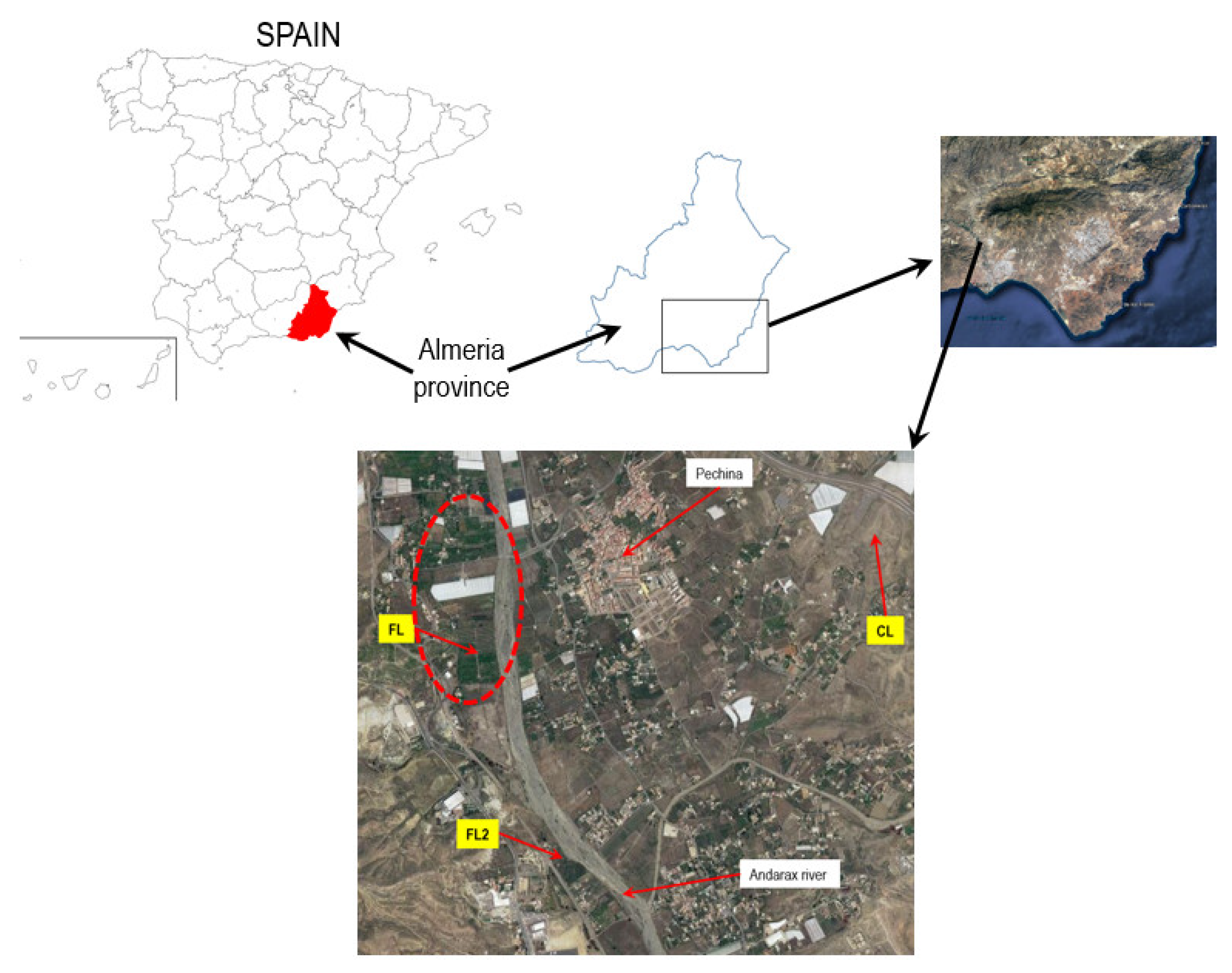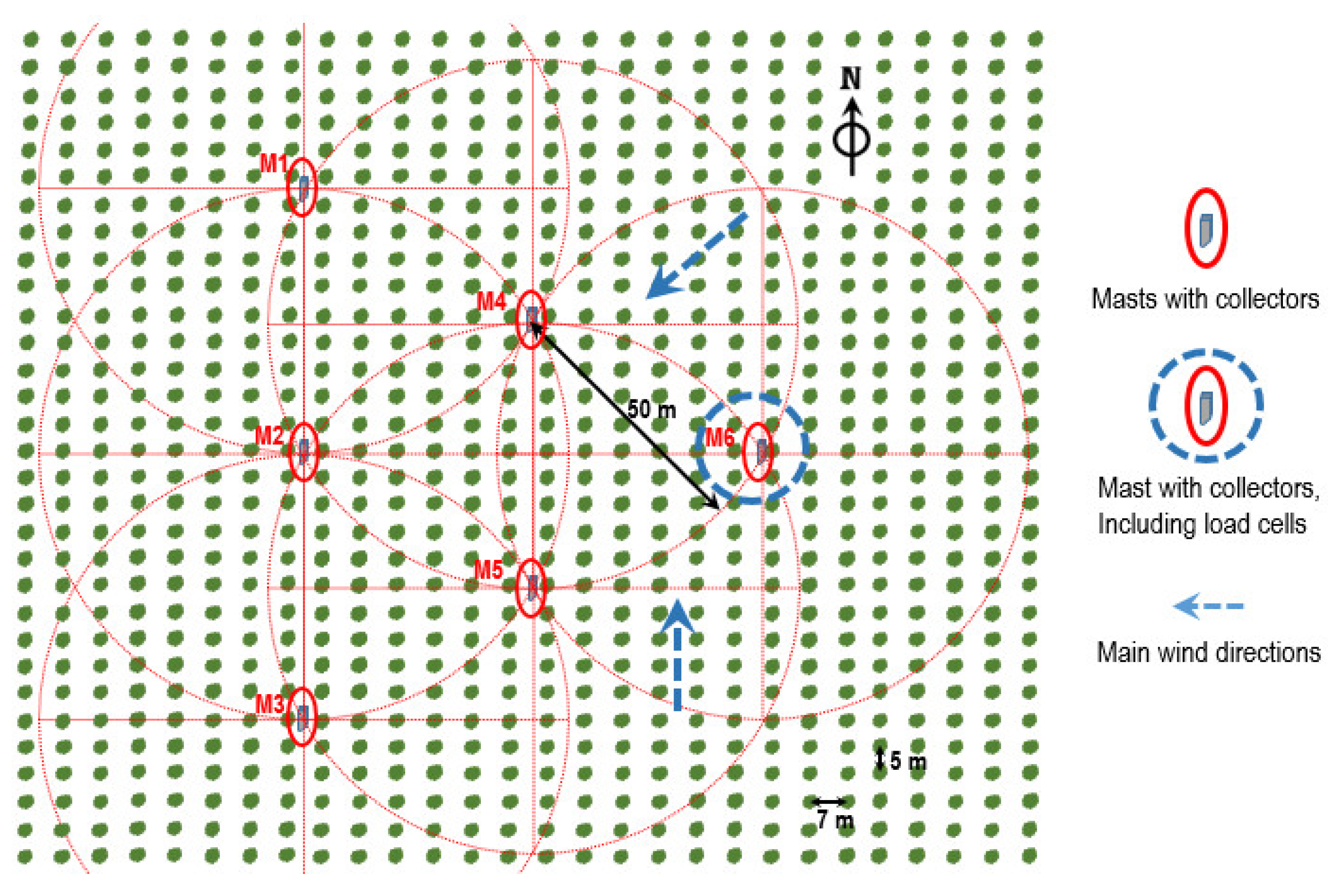Tracking Wind Deposits on Fluvisols in a Citrus Orchard in Southeast Spain: A Test in Real Time
Abstract
:1. Introduction
2. Materials and Methods
- h—maximum height of record;
- q0—sediment at surface;
- α—slope regression factor;
- z—collector height.
3. Results
4. Discussion
5. Conclusions
Author Contributions
Funding
Institutional Review Board Statement
Informed Consent Statement
Data Availability Statement
Conflicts of Interest
References
- Novara, A.; Gristina, L.; Saladino, S.S.; Santoro, A.; Cerdà, A. Soil erosion assessment on tillage and alternative soil managements in a Sicilian vineyard. Soil Tillage Res. 2011, 117, 140–147. [Google Scholar] [CrossRef] [Green Version]
- Sharifikia, M. Environmental challenges and drought hazard assessment of Hamoun Desert Lake in Sistan region, Iran, based on the time series of satellite imagery. Nat. Hazards 2013, 65, 201–217. [Google Scholar] [CrossRef]
- Kravchenko, Y.S.; Chen, Q.; Liu, X.; Herbert, S.J.; Zhang, X. Conservation practices and management in Ukrainian mollisols. J. Agric. Sci. Technol. 2016, 16, 1455–1466. [Google Scholar]
- Yildiz, S.; Enç, V.; Kara, M.; Tabak, Y.; Acet, E. Assessment of the potential risks of airbone microbial contamination in solid recovered fuel plants: A case study in Istanbul. Environ. Eng. Manag. J. 2017, 16, 1415–1421. [Google Scholar]
- Panagos, P.; Van Liedekerke, M.; Jones, A.; Montanarella, L. European Soil Data Centre: Response to European policy support and public data requirements. Land Use Policy 2012, 29, 329–338. [Google Scholar] [CrossRef]
- Touré, A.A.; Rajot, J.L.; Garba, Z.; Marticorena, B.; Petit, C.; Sebag, D. Impact of very low crop residues cover on wind erosion in the Sahel. Catena 2011, 85, 205–214. [Google Scholar] [CrossRef]
- Asensio, C.; Lozano, F.J.; Ortega, E.; Kikvidze, Z. Study on the effectiveness of an agricultural Technique based on aeoliandeposi- tion, in a semiarid environment. Environ. Eng. Manag. J. 2015, 14, 1143–1150. [Google Scholar] [CrossRef]
- De Oro, L.A.; Buschiazzo, D.E. Threshold wind velocity as an index of soil susceptibility to wind erosion under variable climatic conditions. Land Degrad. Dev. 2009, 20, 14–21. [Google Scholar] [CrossRef]
- Colazo, J.C.; Buschiazzo, D.E. Soil dry aggregate stability and wind erodible fraction in a semiarid environment of Argentina. Geoderma 2010, 159, 228–236. [Google Scholar] [CrossRef]
- Colazo, J.C.; Buschiazzo, D.E. The impact of agriculture on soil texture due to wind erosion. Land Degrad. Dev. 2015, 26, 62–70. [Google Scholar] [CrossRef]
- Zobeck, T.M.; Baddock, M.; Van Pelt, R.S.; Tatarko, J.; Acosta-Martínez, V. Soil property effects on wind erosion of organic soils. Aeolian Res. 2013, 10, 43–51. [Google Scholar] [CrossRef]
- Borrelli, P.; Panagos, P.; Ballabio, C.; Lugato, E.; Weynantgs, M.; Montanarella, L. Towards a Pan-European assessment of land susceptibility to wind erosion. Land Degrad. Dev. 2016, 27, 1093–1105. [Google Scholar] [CrossRef]
- Molchanov, E.N.; Savin, I.Y.; Yakovlev, A.S.; Bulgakov, D.S.; Makarov, O.A. National approaches to evaluation of the degree of soil degradation. Eurasian Soil Sci. 2015, 48, 1268–1277. [Google Scholar] [CrossRef]
- Marin, C. Estructura y Evolucion Tectonica Reciente del Campo de Dalias y de Nijar en el Contexto del Limite Meridional de las Cordilleras Beticas Orientales. Ph.D. Thesis, Universidad de Granada, Granada, Spain, 2005. [Google Scholar]
- Goossens, D.; Offer, Z.; London, G. Wind tunnel and field calibration of five aeolian sand traps. Geomorphology 2000, 35, 233–252. [Google Scholar] [CrossRef]
- Mendez, M.J.; Funk, R.; Buschiazzo, D.E. Field wind erosion measurements with Big Spring Number Eight (BSNE) and Modified Wilson and Cook (MWAC) samplers. Geomorphology 2011, 129, 43–48. [Google Scholar] [CrossRef]
- Basaran, M.; Erpul, G.; Uzun, O.; Gabriels, D. Comparative efficiency testing for a newly designed cyclone type sediment trap for wind erosion measurements. Geomorphology 2011, 130, 343–351. [Google Scholar] [CrossRef]
- Guerrero, R.; Valenzuela, J.L.; Monterroso, A.I.; Asensio, C. Impact of wind direction on erodibility of a hortic Anthrosol in Southeastern Spain. Agriculture 2021, 11, 589. [Google Scholar] [CrossRef]
- Guerrero, R.; Valenzuela, J.L.; Torres, J.L.; Lozano, F.J.; Asensio, C. Soil wind erosion characterization in South-Eastern Spain using traditional methods in front of an innovative type of dust collector. Int. Agrophysics 2020, 34, 503–510. [Google Scholar] [CrossRef]
- Guerrero, R.; Valenzuela, J.L.; Chamizo, S.; Torres, J.L.; Asensio, C. Multidirectional traps as a new assessment system of soil wind erosion. Sci. Agric. 2022, 79, 1–7. [Google Scholar] [CrossRef]
- Pulver, T. Hands-On Internet of Things with MQTT: Build Connected IoT Devices with Arduino and MQ Telemetry Transport (MQTT)/Tim Pulver, 1st ed.; Packt: Birmingham, UK, 2019. [Google Scholar]
- Asensio, C.; López, J.; Lozano, F.J. Colector Multidireccional de Partículas Transportadas por el Viento [Multidirectional Collector of Particles Carried by the Wind]. Patent No. ES 2 470 090 B1, 17 April 2015. [Google Scholar]
- Sparkfun. Sparkfun Load Cell Amplifier–HX711. Available online: https://www.sparkfun.com/products/13879 (accessed on 18 March 2022).
- Eclipse Mosquitto™. An Open Source MQTT Broker. Available online: https://mosquitto.org/ (accessed on 18 March 2022).
- Node-RED. Low-Code Programming for Event-Driven Applications. Available online: https://nodered.org/ (accessed on 18 March 2022).
- Gallardo, P.; Salazar, J.; Lozano, F.J.; Navarro, M.C.; Asensio, C. Economic impact of nutrient losses from wind erosion of cereal soils in Southeast Spain. Int. J. Environ. Res. 2016, 10, 333–340. [Google Scholar]
- Segovia, C.; Gómez, J.D.; Gallardo, P.; Lozano, F.J.; Asensio, C. Soil nutrients losses by wind erosion in a citrus crop at Southeast Spain. Eurasian Soil Sci. 2017, 50, 756–763. [Google Scholar] [CrossRef]
- Marzen, M.; Iserloh, T.; Fister, W.; Seeger, M.; Rodrigo Comino, J.; Ries, J.B. On-site water and wind erosion experiments reveal relative impact on total soil erosion. Geosciences 2019, 9, 478. [Google Scholar] [CrossRef] [Green Version]
- Asensio, C.; Molina-Aiz, F.D.; Lozano, F.J.; López, A.; Valera., D.L. Use of mesh windbreaks for soil erosion in olive groves in Southeastern Spain. Environ. Eng. Manag. J. 2019, 18, 2397–2403. [Google Scholar] [CrossRef]







| SAMPLE | Location | Date | Averaged Wind Speed | Averaged Direction | Averaged Temperature | Averaged Relative Humidity | ||
|---|---|---|---|---|---|---|---|---|
| Coordinates | Altitude | |||||||
| (m) o.s.l. | (m·s−1) | (°) | (°C) | (%) | ||||
| CL | 36°55′03″ N | 2°25′27″ W | 138 | 15 March 2022 | 3.4 | 73.4 | 21.1 | 39.6 |
| FL | 36°54′38″ N | 2°26′54″ W | 93 | 15 March 2022 | 3.4 | 73.4 | 21.1 | 39.6 |
| FL2 | 36°54′04″ N | 2°26′30″ W | 82 | 15 March 2022 | 3.4 | 73.4 | 21.1 | 39.6 |
| SAMPLE | V.C. Sand | Coarse Sand | Medium Sand | Fine Sand | V.F. Sand | Coarse Silt | Fine Silt | Clay | O.C. | CO3= |
|---|---|---|---|---|---|---|---|---|---|---|
| (%) | ||||||||||
| CL | 5.8 ± 0.5 | 6.3 ± 0.4 | 9.5 ± 0.7 | 16.3 ± 1.6 | 25.5 ± 1.8 | 7.5 ± 0.8 | 13.7 ± 1.1 | 15.4 ± 1.4 | 0.85 ± 0.11 | 41 ± 3 |
| From NE | 0.0 ± 0.0 | 0.0 ± 0.0 | 0.3 ± 0.1 | 11.3 ± 0.6 | 38.0 ± 2.6 | 22.8 ± 1.8 | 16.4 ± 1.6 | 11.2 ± 2.8 | 0.72 ± 0.14 | 37 ± 3 |
| FL | 2.6 ± 0.4 | 5.0 ± 0.5 | 7.0 ± 0.6 | 8.4 ± 0.9 | 16.5 ± 1.2 | 21.0 ± 1.9 | 19.3 ± 1.7 | 20.2 ± 2.3 | 2.16 ± 0.33 | 24 ± 2 |
| From S | 0.0 ± 0.0 | 0.0 ± 0.1 | 0.2 ± 0.1 | 9.4 ± 0.7 | 36.7 ± 2.3 | 22.4 ± 2.9 | 19.1 ± 2.5 | 12.2 ± 1.1 | 1.12 ± 0.23 | 18 ± 2 |
| FL2 | 4.1 ± 0.4 | 6.2 ± 0.5 | 11.0 ± 0.6 | 12.7 ± 0.9 | 19.5 ± 1.2 | 20.0 ± 1.9 | 12.3 ± 1.7 | 14.2 ± 2.3 | 1.38 ± 0.45 | 20 ± 2 |
| SAMPLE | Qr (Windward NE) (kg·m−1) | |||||
|---|---|---|---|---|---|---|
| 1 | 2 | 3 | 4 | 5 | 6 | |
| FL | 0.1096 | 0.1029 | 0.0889 | 0.1144 | 0.0984 | 0.1173 |
| SAMPLE | Qr (Windward S) (kg·m−1) | |||||
| 1 | 2 | 3 | 4 | 5 | 6 | |
| FL | 0.1928 | 0.1788 | 0.1540 | 0.2013 | 0.1726 | 0.2051 |
| SAMPLE | Qr (MDt Total) (kg·m−1) | |||||
| 1 | 2 | 3 | 4 | 5 | 6 | |
| FL | 0.3505 | 0.3251 | 0.2800 | 0.3660 | 0.3138 | 0.3729 |
| SAMPLE | Qr Balance | |
|---|---|---|
| Windward NE | Windward S | |
| FL | 0.0133 | −0.0225 |
| SAMPLE | Qt (kg) | ||
|---|---|---|---|
| Windward NE | Windward S | MDt Total | |
| FL | 7.1096 | 12.4360 | 22.6101 |
Publisher’s Note: MDPI stays neutral with regard to jurisdictional claims in published maps and institutional affiliations. |
© 2022 by the authors. Licensee MDPI, Basel, Switzerland. This article is an open access article distributed under the terms and conditions of the Creative Commons Attribution (CC BY) license (https://creativecommons.org/licenses/by/4.0/).
Share and Cite
Asensio-Amador, C.; Giménez, A.; Torres, J.L.; Monterroso, A.I.; Asensio, C. Tracking Wind Deposits on Fluvisols in a Citrus Orchard in Southeast Spain: A Test in Real Time. Agriculture 2022, 12, 2138. https://doi.org/10.3390/agriculture12122138
Asensio-Amador C, Giménez A, Torres JL, Monterroso AI, Asensio C. Tracking Wind Deposits on Fluvisols in a Citrus Orchard in Southeast Spain: A Test in Real Time. Agriculture. 2022; 12(12):2138. https://doi.org/10.3390/agriculture12122138
Chicago/Turabian StyleAsensio-Amador, Carlos, Antonio Giménez, José Luis Torres, Alejandro I. Monterroso, and Carlos Asensio. 2022. "Tracking Wind Deposits on Fluvisols in a Citrus Orchard in Southeast Spain: A Test in Real Time" Agriculture 12, no. 12: 2138. https://doi.org/10.3390/agriculture12122138





